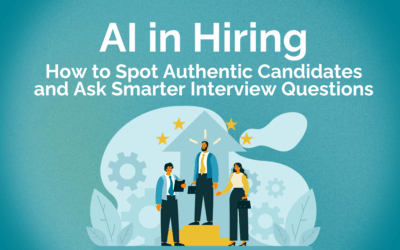What do Zappos, HootSuite, and the 2018 Norwegian Olympic team have in common? A “no jerks” rule. This rule is pretty important when avoiding a bad hire for your company. Bad hires aren’t just costly in quantifiable terms. The far-reaching effects can be harder to determine but even more detrimental. Interestingly, a poor employee is determined by more than a person’s technical skill fit. Soft skills are key indicators of a successful hire. Assuming you have correctly assessed a candidate’s technical aptitude, there’s still the possibility of hiring someone with a harmful attitude. Taking a few steps can ensure a good hire and keep the jerks away.
What’s Ahead:
What is the No Jerks Rule?
The 2018 Olympic team from Norway provides an excellent illustration of the “no jerks” rule. Despite being a smaller team (less than half the size of that year’s US team), the Norwegians won more medals than any other country. More impressively, the team won the most medals ever in a single Olympics. The team follows several guiding principles but it boils down to this: team over ego. No jerks. Or as Alpine skier Aksel Lund Svindal told the New York Times: “There is almost no skill or ability you can have that is so good it allows you to ruin the social qualities of the team.”
How does the Olympic team relate to Zappos and Hootsuite? These companies also know the importance of positive team dynamics. During the interview period, these corporations have famously asked unexpected people for candidate references, such as a driver or administrative assistant who interacted with the applicant. Rude candidates do not make the cut, no matter how stellar their skills. Chieh Huang, CEO, and co-founder of Boxed, has his own “sneaky” set of questions he asks every candidate to weed out jerks. These companies take extra steps because they know that a jerky attitude destroys teams.

Costs of a Bad Hire

According to the United States Department of Labor, a bad hire can cost a company roughly 30% of the employee’s wages for the first year. But because some expenses are more straightforward to quantify than others, the actual cost may be even greater.
To begin with, consider the expenses associated with recruitment activities. According to an SHRM benchmarking report, the average cost-per-hire is $4,129, and it typically takes 42 days to fill a position. Expenses include marketing and advertising job offers, followed by the time invested reviewing resumes and direct costs associated with interviewing candidates.
Once a candidate is hired, employers must factor in lost productivity, time other employees spend training, overseeing, and managing the new team member. The new employee’s adverse influence can result in culture costs, as teamwork and morale take a hit. Additionally, stress levels within teams can rise, potentially resulting in the turnover of good employees.
Issues can also spread outside of a company. Poor interactions with a jerk can damage a companies’ reputation with clients. Damaged reputations will ultimately result in a loss of existing and new business. In the worst cases, you could incur legal fees to resolve disputes caused by the bad hire or dismissal of the poor employee.
No business can afford the widespread damage caused by a bad hire. But the impact of jerks and poor performers on small companies with fewer resources is magnified. So, it is essential to take steps to reduce the risk of hiring a bad fit.
Steps to Identify Ideal Employees
Nearly 74% of hiring managers admit hiring the wrong person for a role. A study by Leadership IQ found that 89% of hiring failures were attributed to a person’s attitude. Shockingly, the study also found that technical skills cause only 11% of hiring failures. With these factors in mind, it is apparent that hiring for attitude and soft skills are key components to successful hiring.
Clearly Define Your Role, and Include Soft Skills
Build a job description that clearly defines both technical and soft skills and expectations. Then be well prepared as an interviewer. Know what technical skills questions you need to ask. If you are not an expert in those areas, bring in someone who is.

Technical competence is often easier to assess than soft skills and, therefore, usually becomes the primary focus of interviews. But remember that technical skills are generally not the reason a hire fails. Our experience placing candidates shows that the ability to build upon existing skills quickly is often more critical than checking each technical skill box. With rapid technology innovations the norm, the ability to quickly learn and the desire to grow with the position may trump an existing skillset. Ask the hiring manager what personality traits make someone successful in this role – attention to detail, quick-decision making, ability to deal with high-stress situations? Include soft skills and personality traits that are currently missing on your team.
Watch for Attitude and Gain Insights
Your job description needs to convey your company’s values, culture, and environment. Once identified, it’s easier to recognize the attributes and traits of a candidate during the interview.
At the same time, watch for clues that the candidate may be a jerk. Signs can include negative or absolute language. Responses that seem overly ambitious or self-important can also be a warning signal. How someone rates a co-worker can also provide insight into the person themselves. If a candidate describes a co-worker negatively, that candidate may be the one with the attitude issues.
Working with recruiting services can also help assess potential employees and help screen out bad hires. For instance, at Boulo, we use our vetting process, including a robust onboarding questionnaire, to develop a 360° Candidate Profile. This profile provides insights about each candidate beyond the resume and cover letter. Among other things, it includes information on technical and soft skills and provides an overall picture of candidate fit for a role. It is one of several ways we help hiring managers to quickly determine which candidates will become successful hires.
Once you have narrowed your candidate choice, check more than professional references. Asking insightful questions from those that know the candidate can provide the information needed to solidify your decision. And help you steer clear of jerks.
Conclusion
Bad hires cost organizations in productivity, profits, and human costs. But there are critical clues and tactics to avoid in making bad hires. These methods may take you more time but include assessing soft skills and watching out for harmful attitudes and behaviors in a candidate. While technical skills are important, the right candidate can often quickly adapt and grow into their role. The most critical indicator of success is the right attitude. Avoid the jerks and stop wasting valuable resources on a bad hire.





0 Comments